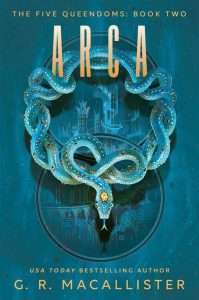Adrian Collins's Blog, page 102
March 27, 2023
REVIEW: The Scourge Between Stars by Ness Brown
The Scourge Between Stars is the debut sci-fi horror by Ness Brown, an astrophysics graduate student and former astronomy instructor. Earth has become uninhabitable due to the unmitigated environmental damage of modern human civilization, and repairing the damage to Earth has been deemed too difficult compared to establishing civilization elsewhere. However, an attempt to colonize a faraway planet has also proved unsuccessful. Now the starship Calypso is headed back to Earth in a final effort to save the last of humanity.
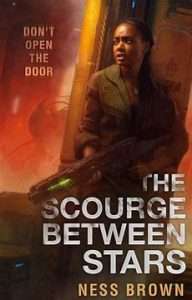 Jacklyn Albright is the acting captain of Calypso, filling the role vacated by her incapacitated father, who remains locked in his quarters, unresponsive to the needs of the crew. Jacklyn is left to face an increasingly dire situation with insufficient food and a growing threat of mutiny. But a new and harrowing threat arises when crew members are found murdered in gruesome fashion, purportedly by a hostile alien on board the ship.
Jacklyn Albright is the acting captain of Calypso, filling the role vacated by her incapacitated father, who remains locked in his quarters, unresponsive to the needs of the crew. Jacklyn is left to face an increasingly dire situation with insufficient food and a growing threat of mutiny. But a new and harrowing threat arises when crew members are found murdered in gruesome fashion, purportedly by a hostile alien on board the ship.
The emergence of this sinister lifeform is a scientific breakthrough, the first proof of extraterrestrial life and therefore worthy of study. However, it is also a menace to everyone aboard the Calypso spacecraft, so the crew must debate about whether the alien should be destroyed or preserved for scientific posterity.
Jacklyn Albright is an outstanding character who endeavors to provide steady and capable leadership in a role abdicated by her reticent father. The rest of the crew make for a great supporting cast, especially the android Watson, whose loyalties operate in a gray area.
Ness Brown’s writing is compulsively readable, and her fast-paced plot kept me flipping through the pages of this short novel. The Scourge Between Stars is a well-written debut, despite several awkward word choices scattered throughout the novel which could be polished with a bit of additional editing.
Notwithstanding the strong cast of characters, The Scourge Between Stars is fundamentally a plot-driven novel. Unfortunately, the plot itself is largely a retelling of the classic space horror Alien, with Jacklyn Albright playing the role of Ellen Ripley. In that sense, The Scourge Between Stars is quite predictable, complete with the initial discovery of alien eggs and the one-by-one gorefest of weary crew members returning to Earth. The main plot twist near the end of the novel would also benefit from further development.
While I enjoyed the characters and the setup of The Scourge Between Stars, the horror elements were not developed well enough to leave a lasting impression. The novel would have benefitted from being more thoroughly fleshed out, with emphasis on providing greater deviation from the familiar plot points of Alien.
Nevertheless, fans of space horror will find much to enjoy in The Scourge Between Stars as Jacklyn leads the crew of the Calypso against an existential extraterrestrial threat. Ness Brown shows promise with her debut novel, and I look forward to reading more from this talented new author.
3/5
Read The Scourge Between Stars by Ness BrownThe post REVIEW: The Scourge Between Stars by Ness Brown appeared first on Grimdark Magazine.
March 26, 2023
REVIEW: Piñata by Leopoldo Gout
Multi-faceted, creative powerhouse Leopoldo Gout’s latest novel Piñata is a visceral possession story that brings together supernatural and real life horrors with a keen look at the brutal legacy of colonial violence that persists today.
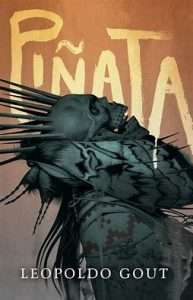 Described as “A Head Full of Ghosts meets Hereditary”, Piñata follows Carmen Sanchez and her two daughters; Izel, the slightly surly teen, and Luna, the wide-eyed 11-year old open and full of wonder for the world around her. Carmen is an architect from New York working on-site at a project in Mexico refurbishing and repurposing an old church into a luxury hotel. Izel and Luna are along for the ride over summer vacations as Carmen hopes they can connect to their heritage through immersion in the local culture.
Described as “A Head Full of Ghosts meets Hereditary”, Piñata follows Carmen Sanchez and her two daughters; Izel, the slightly surly teen, and Luna, the wide-eyed 11-year old open and full of wonder for the world around her. Carmen is an architect from New York working on-site at a project in Mexico refurbishing and repurposing an old church into a luxury hotel. Izel and Luna are along for the ride over summer vacations as Carmen hopes they can connect to their heritage through immersion in the local culture.
What begins as a hopeful quest for exploring their identities quickly becomes a tense nightmare as Luna is targeted by dark and hungry forces intent on bringing about the end of the world. After local Nahua woman, Yoltzi, tries to warn Carmen of the danger Luna is in, things begin to unravel until an accident at the work site means the Sanchezes have to head back to New York.
Heading home is not the end of their troubles as the worst is yet to come for this small family with visions, accidents and misfortune falling on them at every turn. Luna is almost entirely consumed by the ancient spirits intent on using her as a portal into the physical realm. Piñata is full of dark imagery that pulls at the sanity of its characters and, if one word could describe it, that would be ominous.
The story pulls you in different directions; for all that you want Luna and her family to survive, Piñata has been framed in such a way that you can empathise with these spirits trying to exact their revenge on the colonisers who tortured and slaughtered their people centuries ago. These spirits aren’t strictly framed as ‘evil’, and even try to protect Luna from bullies at school; their revenge feels justifiable, which adds something more complex to your average possession story.
Piñata also delves into cultural erasure as a key theme; the concept of a piñata itself being formed through stages of cultural erasure, the Nahua culture erased by colonisers, Mexican culture being erased by widespread violence, and the culture of the Sanchezes themselves seen in Carmen putting up a façade to make herself palatable in corporate America, or Izel wanting to change her name to something “normal”.
This was an excellent read, well written and executed with dark, visceral themes, imagery, and events. Piñata is a hall of mirrors, reflecting back on itself and its themes throughout to superb effect. The tension is maintained right to the end and even down to the last 20 pages it is difficult to tell which way the ending will go. A tight and vibrant horror novel that will keep you thinking.
4/5
Read Piñata by Leopoldo GoutThe post REVIEW: Piñata by Leopoldo Gout appeared first on Grimdark Magazine.
March 24, 2023
REVIEW: A Day of Fallen Night by Samantha Shannon
A Day of Fallen Night is Samantha Shannon’s standalone prequel to her acclaimed feminist fantasy, The Priory of the Orange Tree.
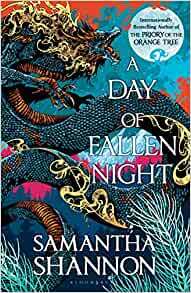 Shannon introduces us to an entirely new cast of characters in A Day of Fallen Night, which takes place about 500 years before the events of Priory. As in Priory, Shannon excels at creating a strong cast of female characters with excellent queer representation.
Shannon introduces us to an entirely new cast of characters in A Day of Fallen Night, which takes place about 500 years before the events of Priory. As in Priory, Shannon excels at creating a strong cast of female characters with excellent queer representation.
The three lead protagonists represent each major region of the world—East, West, and South—which have very different religions, political structures, and cultures. In the East, the mountain-dwelling Dumai trains as a godsinger, establishing a connection between humankind and the dragons that her society worships. In the West, Glorian is the young heir to the queendom of Inys who struggles with her royal calling. In the South, Tunuva is a warrior from the mysterious Priory of the Orange Tree, a religious organization who follow the Mother and are committed to defeating the Nameless One, an enormous fire-breathing dragon.
While Samantha Shannon already shined at creating strong, emotionally complex female leads in The Priory of the Orange Tree, the male characters were underdeveloped by comparison. In A Day of Fallen Night, Shannon avoids this problem by introducing Wulf, a young man from the North who becomes the fourth main protagonist in the second part of the book. Wulf strives to find his calling in a world that underestimates him, proving to be a multidimensional character every bit as compelling as the three female leads.
The main story of A Day of Fallen Night concerns the reawakening of an ancient evil and its impact on each of our main protagonists and their respective lands. Through it all, Shannon keeps returning to two main themes: the importance of finding oneself and the power of love in all its forms. The author proves especially adept at depicting relationships among her characters, including several queer relationships.
The main problem with A Day of Fallen Night is its inconsistent pacing. After an exceptionally slow start, the plot sputters in fits and starts but never rises to the same level of intensity as in The Priory of the Orange Tree. Every time I felt like the story was gaining traction, it would be interrupted by an ill-timed chapter break and associated change in perspective. Rather than sequencing chapters to help build momentum or reinforce certain aspects of the story, the alternating perspectives give the novel a disjointed feel, compromising the flow of the story.
The latter part of the book becomes more exciting as the paths of our protagonists intersect. However, the payoff is not commensurate with the long time invested to reach that point. The ending of the book features several plot twists, but most of these were rather predictable.
Given that both The Priory of the Orange Tree and A Day of Fallen Night are standalone novels set in the same world, which book is the better place to start? Readers who prefer chronological order should start with A Day of Fallen Night, but otherwise my recommendation is to begin with The Priory of the Orange Tree, which offers a more accessible introduction to the world and a more engaging story.
Overall, A Day of Fall Night is a beautifully written epic fantasy full of nuanced character development, but it suffers from disjointed flow and fails to deliver a story that justifies its 880-page girth.
3/5
Read A Day of Fallen Night by Samantha ShannonThe post REVIEW: A Day of Fallen Night by Samantha Shannon appeared first on Grimdark Magazine.
March 22, 2023
REVIEW: Cold West by Clayton Snyder
Cold West begins as a story of loss and resolve. A weird west story set within a dying wasteland, full of the ruthless and the uncanny. A world where magic births chaos. Clayton Snyder’s Cold West fires on all cylinders.
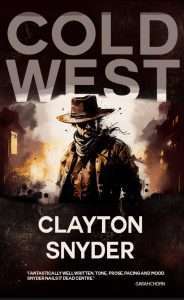 As a former bounty hunter, Wil Cutter paved his legacy by blood. He was the unrelenting. A professional killer. When he met Ginny, he buried his past. He traded his guns for a plow and a family. And then Ginny died. His farm failing and having no cash to feed his two boys, Wil is left with little choice but to take another contract. There is a path and his family. He’ll destroy all else. He’ll learn he never should have returned to the fold.
As a former bounty hunter, Wil Cutter paved his legacy by blood. He was the unrelenting. A professional killer. When he met Ginny, he buried his past. He traded his guns for a plow and a family. And then Ginny died. His farm failing and having no cash to feed his two boys, Wil is left with little choice but to take another contract. There is a path and his family. He’ll destroy all else. He’ll learn he never should have returned to the fold.
“What will they say about me when I’m gone, then? Not much, likely. He was a bastard and a liar. A rotten thief. A killer. But mostly I was fed up. And a fed-up man’s got a lot of moral leeway.”
While action-packed, Cold West is about Wil’s inner journey. We are given flashbacks of Wil and Ginny’s courtship. Ginny’s love had saved him. Now her death threatens to corrupt him beyond salvation.
However, Clayton Snyder doesn’t confine Cold West to a tragic love story. Wil Cutter’s quiet reflection on his life and his cruel justifications for his actions are harrowing. His perspective is damning but offers an intelligent perception about his world.
“I’d never been a good man, so when Ginny’d come along, I’d tried all that much harder to be. Lesser concerns didn’t trouble me on that path. Things like others standing in the way. Though, that had never been the heaviest weight on my shoulders.”
The Waste in Cold West harbors strange magic. Wil Cutter is a Null, someone who can create tunnels through the Empyrean and open gates to other dimensions. This magic reminds me as a cross between The Misery from The Raven’s Mark and the Warrens in Malazan.
Weird West is one of my favorite subgenres. Given this subgenre’s hybrid nature, no two stories are very similar. Everything from HBO’s West World to Mad Max, Papa Lucy and the Boneman to The Songs of Sefate, they all spin their own unique take on western stories. I love seeing the typical West landscape transform into extraordinary nightmare. Cold West is a tribute to fantastical worldbuilding.
Cold West is an action-packed fusion of horror, dark fantasy, and the wild west. The waste territory in Clayton Snyder’s novel is delightfully hellish. His characters equally so. I hope Clayton Snyder returns to this world.
Read Cold West by Clayton SnyderThe post REVIEW: Cold West by Clayton Snyder appeared first on Grimdark Magazine.
March 21, 2023
An Interview With Mia Tsai
Taiwanese American author Mia Tsai just released her first novel, a xianxia-inspired contemporary fantasy titled Bitter Medicine. It combines myth, religion, and magic with a splash of romance into an engaging story that I believe even the darkest grimdark readers will enjoy. Mia was kind enough to chat with me about some of her writing inspirations, the concept of code-switching, and how her varied language background influenced her writing.
 [GdM] Is there any part of the process of writing a book that you especially like?
[GdM] Is there any part of the process of writing a book that you especially like?
Editing! The good stuff happens in editing, though occasionally I’ll have a nice moment during drafting when I look at what I just wrote and go, “Huh, not bad.” Taking the raw material and shaping it is what I really enjoy, even if sometimes the edits are tough and involve significant rewrites. I’m just not a fan of drafting, so the happiest place for me is in line edits.
[GdM] As a professed plant geek myself, tell me about orchids. Which ones are your favorite and why?
My personal favorite is the miltoniopsis, which is the first species I was able to keep alive at home. They’re such great indoor plants that don’t require a ton of care once you find the right light conditions, and a lot of them are lightly fragrant and flower consistently once a year for at least a month at a time. They’re not really trendy, but they’re really steadfast and a joy to look at. I also like dendrobiums a lot—there’s just so much variety with dendrobiums, and a lot of the dendrobium nobiles are fragrant, so you can pick up a bunch of dendrobiums and miltoniopses and have a lovely little garden going.
But I think all orchids are super cool, especially the ones that have evolved little moving parts to attract their pollinators, like bulbophyllums. There’s a bulbophyllum, bulbophyllum graveolens, that has this jiggly red tongue to attract its pollinator, which is a type of fly. It also smells gross, like stale water. I also appreciate the orchids that tape their seed pods to whatever touches the trigger hairs! The glue is pretty strong.
[GdM] Please tell us a bit about your new novel, Bitter Medicine.
Bitter Medicine is an adult contemporary fantasy with romance that has a magic system that’s been inspired by xianxia. So in addition to the flying around that you can get with wuxia, you have a character who can imbue calligraphy with her energy to transform the words into the meaning of the words, who’s able to use traditional Chinese medicine to a degree we aren’t capable of in the real world, who can summon fire, et cetera.
The novel is a romance between our two main characters, but they’re so entangled in their own personal conflicts—Elle with her family, Luc with his incredibly demanding job—that it’s hard to find the space for a relationship, let alone a romance with someone who is likely into you but can’t say it.
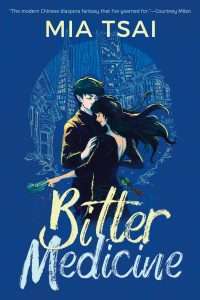 [GdM] How did you decide on the title Bitter Medicine?
[GdM] How did you decide on the title Bitter Medicine?
The original title when I first started querying was A Brush with Love, but it was rightly pointed out to me that it sounded like a dentistry rom-com. So I went back to the drawing board and did a word cloud and after some light agonizing, decided Bitter Medicine was a much better encapsulation of the themes in the novel and was better able to hint at Elle’s roots, being a descendant of the Chinese god of medicine and all.
[GdM] Bitter Medicine is your first novel. What has the publishing experience been like from start to finish?
It’s been a lot of waiting interspersed with heart attacks. That’s one of the worst parts, the waiting. There will be months where nothing happens on your end and nothing is in your control, and it takes some time to reconcile that. It also takes time to internalize how impersonal the feedback you get is, sometimes. Rejections aren’t direct attacks, they’re just vibe checks you failed. And I still get rejected quite often, so I keep that muscle strong.
I’ve been very fortunate to have a pretty smooth publishing journey; I haven’t struggled too much but for the waiting! I’m already an editor, so taking edits wasn’t too difficult. I thought I’d be anxious for launch, and I was, but I calmed down before it and it’s been a good, positive experience.
[GdM] The world you created is so fascinating. It is a combination of myth, religion, and magic. What was the catalyst for the world?
My student had lost a tooth, and I asked if the tooth fairy was coming. Now, my student is first-generation Indian American, so it’s not guaranteed that a tooth fairy will show up at all, and my student said she didn’t. I joked that she must have had a sick day, which then kicked off the idea of the fairy temp agency.
I did then start wondering whether other cultures had any lost tooth traditions, and as it turns out, they do! There are tooth mice, for example. So of course, in the fairy temp agency, the world needed to be expanded so temps could fill niches internationally, and soon I had a globe-spanning agency with boards of directors for each continent and a foundation for many, many stories.
[GdM] Tell me about Luc’s and Elle’s characters. What are they like, and how did they develop that way?
They sort of appeared the way they are! I like characters who are a little goofy and silly, and Elle is definitely that, despite being well over a hundred years old. Maturity-wise, she’s in her thirties, so she’s very capable at doing Adult Things like holding down her job, paying her bills on time, handling the small mundanities of grown-up life. But she also likes being lighthearted and is a curious person. And by curious I mean a person who has retained her curiosity and not a person who is curious and odd, though she can be that sometimes. The levity is important to have for someone in her situation. She’s definitely the kind to break tension with a bad joke, and she hates it when other people are fighting. She’d rather everyone get along or work out their problems in a non-contentious way.
Luc is someone who, if you looked in the dictionary to find the definition of serious, you’d see his picture there. I always thought of him as impassive but secretly caring; the stoicism and ability to compartmentalize, sometimes to the detriment of his emotional health, was necessary for the job I gave him. He’s long-lived as well and has kind of a hectic career, so he’s more the type to slow down when he’s not working, to relax at home and enjoy the pleasures of life, whether that’s good food and drink or sleeping in half the day.
[GdM] There is a beautiful lightness to the romance in Bitter Medicine. It feels effortless. Did the lightness between Elle and Luc develop organically?
It did, surprisingly! I’m not much of a plotter when it comes to writing. I’ll use tentpoles to get through the story once I figure the characters out, but the first step is to figure out the characters. The best way for me to do that is to throw them into a room and see what happens. To my delight, Elle brought out a humor in Luc that I hadn’t planned for, and when he’s around, she’s able to reach the harmony and lightheartedness that she values.
Elle uses a logographic magic system which seems like dancing when employed. How do you imagine Elle’s movements? Was it akin to dancing or painting? Do you have a reference book of glyphs for Elle?
It’s definitely painting. I did Chinese brush painting as a kid, so all the ink grinding and prepping for painting is taken directly from my sense memories. Calligraphers are magical to me in that they have to be in the correct mindset and confident in their movements prior to painting a character, and any hesitation ruins it. It’s like a performance; the show must go on. I watched a lot, and I mean a lot of calligraphy videos on YouTube to observe how different each artist is.
I don’t have a reference book of glyphs because some of them are simply Chinese characters, but I do have reference books for the etymology of Chinese characters, which was necessary because Elle is armed with that knowledge and can change how her magic manifests by using different scripts and characters from across Chinese history.
[GdM] Can you explain code-switching and how you used that in the novel?
Code-switching is the ability to go in and out of different languages or dialects as you’re speaking to someone who also understands the languages or dialects you’re using. Sometimes, the other language just conveys the meaning better, or you yourself speak differently when you’re using the other language. It’s a daily part of life for a great many people on this planet, including for the characters in Bitter Medicine, who mostly speak English as a second (or third, fourth, fifth, you get the idea) language.
The characters code-switch for multiple reasons, one of which is so that another character can’t understand them. I think most people feel that’s why others will speak in another language, even if that’s not true. The characters also code-switch to purposely bring up memories, as language is intimately tied to time and place, and to express sentiments that English can’t. And of course, the characters will code-switch with each other because they’re most comfortable in a non-English language and that’s the language they reach for first.
[GdM] In the afterword of Bitter Medicine, you spoke about language. Could you elaborate on that? You came from a varied language background; how did that influence your writing?
It’s true that I’ve had lots of experience with languages I don’t understand being spoken around me! I was born in New York City and for a time lived in Brooklyn, so the languages I heard were English and Hebrew, with Mandarin at home. I don’t think there’s ever been an extended period of time when I wasn’t being exposed to languages I didn’t understand—I listened to a lot of international music growing up, including Japanese rock, which I never fully understood but liked anyway. I sang a lot in other languages for choir and had to relearn Mandarin when I was in Taiwan. And they code-switch willy-nilly over there; you can be having a conversation in Mandarin and the other person will switch to Taiwanese Hokkien or start heading that direction by altering their Mandarin accent to get closer and closer to Taiwanese.
So I didn’t really have to think about including it in a contemporary, international story of my own making. It was just there because I do it myself. It’s not a conscious decision to go from thinking in English to thinking in Mandarin, for example. And I long ago learned that language choice is about the speaker’s comfort, not the listener’s, so if you’re eavesdropping on a conversation that isn’t in a language you understand and you get upset that they won’t speak X language, that’s more on you than anything else.
[GdM] I read your blog post about the decolonization of science fiction and fantasy and found it fascinating. “Did it mean consciously removing colonialist and imperialist thinking? Did it mean exploring non-three-act structures and educating Westerners on what they were, their history, and what to expect? Did it mean creating fiction set in post-colonial worlds?” How does this idea of decolonization relate to Bitter Medicine?
I think the most decolonial thing about Bitter Medicine is the code-switching without translation, or maybe the parts where I decline to explain in excrutiating detail what certain cultural elements are. Otherwise, it’s built on a pretty colonial world! English is the lingua franca, with Mandarin close behind; Western systems really dominate. Even the two-act structure I use in Bitter Medicine comes from Western art, like musicals and operas. I’m not saying that being expressly anti-Western is what it takes to be decolonial, though. There’s plenty of colonial and imperialist thinking in non-Western countries. I am saying we should examine ourselves and figure out whether our expectations in fiction come from a colonial mindset, where things exist to be explained or conquered instead of being left to exist without interrogation.
[GdM] You write like someone who loves books. Who is in your bookcase?
I do love books! My bookshelf at home is mostly fantasy, nonfiction, and reference, with some poetry. So I’ve got Robin Hobb on the shelf, a lot of Garth Nix, Anthony Bourdain books, Toni Morrison, orchid care books, Edith Hamilton’s Mythology and multiple other mythology books, and my favorite young adult and middle grade books from when I was growing up. At the studio, I curate a 90% BIPOC collection, so it’s a mix of contemporary and speculative fiction in the adult and young adult categories, some early readers and picture books for my students, plus a lot of music scores.
[GdM] What is next for you! Please tell me there is a sequel in the works with Elle’s brother!
I’d love to tell you that The Book of Tony is coming, but alas, I cannot! I’ve got an adult science fantasy on submission right now called KEY & VALE, which is about an anthropologist with the ability to experience epigenetic memories whose job it is to find lost knowledge and bring it back to the Museum of Human Memory and what happens when she finds a memory that calls into question everything she’s on which she’s built her paradigm. I also have a number of other projects in early development and I can’t decide which one to work on! Maybe I’ll just take a break for a couple of weeks.
READ BITTER MEDICINE BY MIA TSAI
The post An Interview With Mia Tsai appeared first on Grimdark Magazine.
March 20, 2023
REVIEW: Dungeons and dragons: Honor Among Thieves
Dungeons and Dragons: Honor Among Thieves made me tear up a bit at the end. It was an involuntary reaction, I certainly didn’t intend for it to happen, but it’s something that occurred nevertheless. Against my better judgement, I came to care about these characters and whether they managed to make it through the end of the movie. So, in the words of Rick and Morty, “You son of a bitch, I’m in.”
The movie isn’t perfect by any stretch of the imagination but it is recognizably and explicitly Dungeons and Dragons. Which is a harder thing to embody than many people might think. Dungeons and Dragons isn’t a setting by itself but a method of creating and playing a setting. This is the problem of previous adaptations because you can play any fantasy setting with D&D rules but you can’t just say, “Dungeons and Dragons is the setting.” Here, it’s the Forgotten Realms and I kind of wish they’d called it Forgotten Realms or Neverwinter Nights because either of those titles would have been appropriate as well.
Energy-wise, this is a Marvel Cinematic Universe movie for better and worse. I honestly compare this most to Paul Rudd’s Ant Man movie in terms of rough mixture between family melodrama, quips, and action. Well, this has a lot more dragons in it and I’ll give that is an impressive boost over Ant Man. It’s a movie about a failed father trying to reconnect with his daughter, a heist, and an oddball crew of misfits. So let’s say Ant Man meets Guardians of the Galaxy meets dragons. Which, yes, is probably why I love this movie against my better judgement. Neither of those films are my favorite Marvel films but throw in an owlbear and the Red Wizards of Thay? Yeah, now we’re cooking with fireballs.
The premise is somewhat overly complicated at the start with, essentially, an entire movie’s worth of backstory in the prologue that could have been the first part of a trilogy. Edgin Darvis (Chris Pine) is a Harper who turns to thievery after his do-goodery gets his wife killed by the Red Wizards. He ends up as heterosexual but platonic partners with Holga (Michelle Rodriguez) and raises his daughter, Kira, with her. Hearing there’s a magical tablet that can raise his wife from the dead, Edgin robs the Harpers and gets sent to magical prison with Holga when the heist goes wrong. They break out and decide to get Kira back from their partner who, obviously, betrayed them but is raising the girl as his own.
This is just the prologue.
The movie is mostly a heist film with our leads recruiting bumbling sorcerer Simon Aumar (Justice Smith) and kickass Tiefling druid Doric (Sophia Lillis) to help take down Lord Forge Fitzwilliam (Hugh Grant) as well as his Red Wizard partner Sofina (Daisy Head). They go from action scene and comedy scene to action scene to comedy scene with the movie never really taking a break. Some of the comedy is stupid like a scene where they waste their Speak with the Dead questions while other comedy is stupid but entertaining as hell (Holga’s ex being a halfling? Eh. Holga’s ex taking up with another Amazonian barbarian? HILARIOUS).
The movie is utterly drenched with fanservice and you’ll be unable to turn off your brain from the, “I recognize that, they said the thing, I recognize that, reference to that thing I know!” Memberberries (i.e. things you remember from your childhood) are a pretty low form of humor perfected by Buffy: The Vampire Slayer and Iron Man but it works on the nerd side of my brain. When they mention Simon is Elminster’s descendant, I went, “Yeah, him and half of Faerun” and realized they’d gotten me.
I feel almost bad about how mad I am for unabashedly loving this movie. I am deeply cynical about Hasbro’s handling of D&D and mad at them for a dozen things ranging from the OGL to the novels being abandoned. However, this movie has an morbidly obese red dragon, the cast of the Eighties Dungeons and Dragons cartoon, and Szass Frigging Tam (who is the villain of my current D&D campaign).
What am I supposed to do with that? I can’t stay mad at a movie trying this hard to entertain me. The cast is a bunch of bumbling misfits and everyone looks like an idiot but Doric (Michelle Rodriguez gets a lot of mileage out of being a dumb barbarian), yet I can’t complain about that since it’s my style of humor too.
They’re also competent when it counts. I even like Hugh Grant in this as he basically shows what he would have been like if he’d play Gilderoy Lockhart in Harry Potter and The Chamber of Secrets. Literally my only complaints are the fact that I wasn’t aware Faerun was enlightened enough to have prisons with a healthy pardon system and the fact movie dragged in literally two places.
See the film.
The post REVIEW: Dungeons and dragons: Honor Among Thieves appeared first on Grimdark Magazine.
March 19, 2023
An Interview With Laurell K. Hamilton
If you have been an urban fantasy reader in the last thirty years, you will have heard of Laurell K. Hamilton. Hamilton’s first novel Nightseer, a stand-alone, was published in 1992. However, since then, her massive influence on the culture of urban fantasy cannot be overstated. She is one of the queens of urban fantasy and in her 29th book Smolder coming out later this month, the eponymous Anita Blake, a vampire hunter, private eye, and necromancer working in St. Louis, feels like she is just getting started.
 There is a definite darkness in the Anita Blake books, so if you want your urban fantasy to have a rawer edge, look no further.
There is a definite darkness in the Anita Blake books, so if you want your urban fantasy to have a rawer edge, look no further.
Hamilton had a lovely chat via email with me, where we discussed her newest novel, Smolder.
[GdM] I read Pigeons From Hell by Robert E. Howard was the short story that put you on the road to being a writer. Is that true?
Answer: Almost, I already knew I wanted to be a writer, but reading this anthology made me decide that I wanted to be a writer of fantasy, dark fantasy, heroic fantasy and horror. I’d written several stories but never finished one until after I read these stories, then I started a new story and finished it. It was horror and from that point on I never looked back.
[GdM] At its heart, Anita Blake is a hard-boiled detective fiction. Have you always gravitated toward these kinds of novels? Were you reading hard-boiled detective novels as a child?
Answer: I actually didn’t read much mystery until I was in college. I didn’t fall in love with hard-boiled detective novels until I graduated and moved to Los Angeles. We’d moved there because my first husband had gotten a great job offer. It took me longer to find a job, so I used the local library a lot. I discovered Robert B. Parker’s Spenser series first, which led me to Dashiell Hammett and Raymond Chandler. I wondered if there were any female writers or detectives in the genre and found Sue Grafton’s Kinsey Millhone and Sara Paretsky’s V. I. Warshawski. This was the 1980s so they were pretty much it for women in the field.
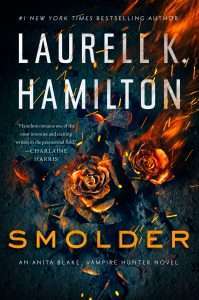 [GdM] Have you ever thought about going back to Nightseer and writing a second book?
[GdM] Have you ever thought about going back to Nightseer and writing a second book?
Answer: I have, and if Nightseer had sold well enough for my publisher to want to publish the second book and then help me finish the series I might never have written the first Anita Blake novel and jump started the career I have today. Ironically my current publisher bought my first publisher so I might still get a chance to finish the series someday.
[GdM] You are a practitioner of Filipino Martial arts. Has your martial arts education helped you write fight scenes? If so, how?
Answer: Absolutely. In research I always find that if I can do even some of the physicality of what I’m writing that I learn things I could never have learned by reading or interviewing people about a topic. But FMA in particular is a combat arts system not a martial arts system made for tournaments. It’s helped me look at blade work and fighting in general in a way that no other system I’ve tried over the years ever has. I was good at fight scenes before, but my seven years in FMA has helped me reach deeper on paper and off.
[GdM] As a long-time reader of your novels, you unflinchingly create characters that deal with various forms of mental illness. Your audience can always look at your characters and feel seen. How have you approached the representation of mental illness in your stories? Do you ensure accuracy through research, sensitivity readers, or other means?
Answer: I’ve been in therapy off and on for decades, so some of it is personal experience. Researching to understand my issues and my family’s issues led me to research other things. I have also had the honor of people sharing their own painful truths with me. All of that has made Anita and the characters in her world richer and more real than they would have been without it.
[GdM] The expression of characters’ sexuality is something you have always written about that feels open and honest. Has the way you approached sex scenes and sensuality changed between the first novel and now, and if so, how?
Answer: When I started writing the series my plan was to have every kiss, every caress so amazing that we wouldn’t need to ever complete the act. What actually happened was that I built up the anticipation higher and higher so when it came to the point where Anita was finally ready to have full blown sex I had to live up to all the amazing foreplay. I was incredibly uncomfortable with the idea of doing it on paper, but I’d written crime scenes and fight scenes with extreme violence in them and not hesitated. The fact that sex between two people that cared about each other bothered me more than writing violent murder made me question my priorities. Was sex really worse than violence? No, no it wasn’t, but in America we’re conditioned that it is, and once I realized where the bias came from I was determined not to be trapped by it. I promised myself that every sex scene would be as well written and unflinching as my murder scenes had been. I think I’ve kept that promise to myself and to my readers.
[GdM] Anita and Merry have very different attitudes. Do you need to be in a specific mind frame to write them?
Answer: Not different mind frames, but I have to work to find their individual voices. My newest protagonist Zaniel Havelock was even more of a challenge because he was my first male first person narrator. At least with Anita and Merry they are both female and smaller like myself, but for Zaniel I had to explore a new world from the viewpoint of a man who was 6’ 3” a foot taller than Anita and myself, and thirteen inches taller than Merry. Not to mention all the rest of the differences.
[GdM] One of the most exciting things for me as a reader of the Anita series is its freshness. Due to the large cast, most characters will eventually have their day in the sun. There are no minor characters; you just haven’t gotten to them yet. Is this one of the ways in how you keep Anita speaking to you as an author?
Answer: I think it is one way I stay fascinated with the world and the characters. I coined the term minor major characters for the larger cast, because every one of them is a new world to explore and add to the existing one.
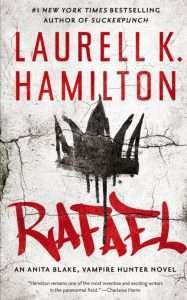 [GdM] Can you tell us about your newest entry in the Anita Blake series, Smolder?
[GdM] Can you tell us about your newest entry in the Anita Blake series, Smolder?
Answer: I’m really bad at talking about a book without giving too much away, but I’ll do my best. We learn more about Anita’s family and her relationship with them than ever before. We get insight into why she’s never visited them on stage in any book. A major new threat is introduced that will challenge Jean-Claude and Anita as never before. It will force them to reach out for help to an old ally that hasn’t been center stage in the books in a long time. We will see the first of the wedding outfits on stage. We add new world building for my vampires and expand on my magic system in general. We have a first in the Anitaverse for mythology. It was so new that I didn’t include a bibliography in the back of Smolder because I thought it would give the surprise away.
[GdM] Who is Anita now in book 29 versus who she was when she started?
Answer: Anita started out as Episcopalian, nearly celibate and looking for Mr. Right, monogamy, raising zombies as her main job, and being a supernatural consultant for the police. She believed utterly that vampires were walking corpses and that it wasn’t murder to kill one. The last line of the first book, Guilty Pleasures, summed it up, “I don’t date vampires, I kill them.” In the twenty-ninth book, Smolder Anita is still Episcopalian, but almost everything else has changed. Raising zombies has become her part time job, because she’s now a US Marshal with the Preternatural Branch of the regular US Marshal Service. She’s polyamorous and part of a large, complicated poly group that includes women as well as men. All the members of the group are either shapeshifters or vampires. In fact she’s engaged to be married to Jean-Claude, the newly proclaimed vampire King of America. Some fans keep asking if marriage will suddenly make Anita and Jean-Claude monogamous, but they are polyamorous and that won’t change just because of a wedding.
[GdM] How would you describe Anita’s relationship with her father?
Answer: I can’t really answer that without giving too much away. Let’s just say, it’s a rocky relationship.
[GdM] Is there a happily ever after for Anita? Her story seems ever-evolving.
Answer: I think where most stories end with their happily ever after is where real life happily ever after begins. That’s what I believe in real life and that’s how I write my fiction.
[GdM] Is there any news on a new Merry book?
Answer: I’ve started making notes on it, and building the plot on paper.
Laurell K. Hamilton is a full-time writer and the #1 New York Times bestselling author of the Anita Blake, Vampire Hunter series; Zaniel Havelock series; and the Merry Gentry series. She lives in a suburb of St. Louis with her family. Learn more online at www.laurellkhamilton.com.
READ SMOLDER BY LAURELL K. HAMILTONThe post An Interview With Laurell K. Hamilton appeared first on Grimdark Magazine.
Classical Mythology Inspired Fiction: Where to Start Reading
Over the last few years, stories inspired by mythology have become an integral part of fiction, spawning off a sub-genre of retellings. Personally, I’m here for all of them and have been devouring any and all I’ve been able to get my hands on – but if you haven’t, where to start? I’ve sat down with the team and put together a list of great books to start reading stories based on Classical mythology! This is the first part of a multi-part series on books inspired by myths and legends, with Arthurian novels to follow next.
Circe
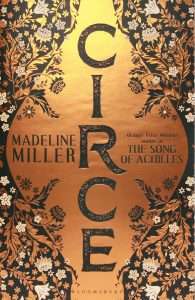 Madeleine Miller is the original queen of this wave of retellings. Her The Song of Achilles and Circe are classics for a reason – and especially Circe is a brilliant story giving a woman agency rather than being a footnote in someone else’s story. Circe had always been fascinating to me through her small role in the Odyssey and reading this when it came out some years ago is what drew me to retellings. A must-read if you’re getting into retellings!
Madeleine Miller is the original queen of this wave of retellings. Her The Song of Achilles and Circe are classics for a reason – and especially Circe is a brilliant story giving a woman agency rather than being a footnote in someone else’s story. Circe had always been fascinating to me through her small role in the Odyssey and reading this when it came out some years ago is what drew me to retellings. A must-read if you’re getting into retellings!
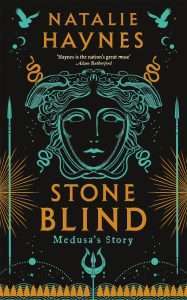 Medusa might be my favourite female figure from Greek myth. And she has absolutely no time for the mediocre men who make her life a mess – and Natalie Haynes’ Stone Blind nails that sentiment. Told partially by the Gorgoneion – Medusa’s slayed head – Stone Blind has the advantage of hindsight and a snarky narrator who takes no shit. It is compelling and thoroughly feminist. A true story of the gods’ whims and how they favour undeserving mortals and the impact this has on the women around them.
Medusa might be my favourite female figure from Greek myth. And she has absolutely no time for the mediocre men who make her life a mess – and Natalie Haynes’ Stone Blind nails that sentiment. Told partially by the Gorgoneion – Medusa’s slayed head – Stone Blind has the advantage of hindsight and a snarky narrator who takes no shit. It is compelling and thoroughly feminist. A true story of the gods’ whims and how they favour undeserving mortals and the impact this has on the women around them.
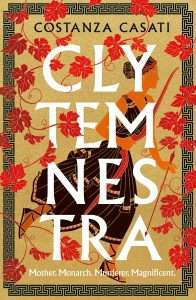 Constanza Casati’s Clytemnestra is a fascinating portrayal of one of the most complex human women in Classical mythology. A fiercely loving mother, ultimately killed by her own children in a series of revenge acts. This take on her story is written in brilliant prose, taking the reader through Clytemnestra’s life from childhood to the more famous parts and creates a multi-layered anti-hero to root for. The pacing is just right and tension is kept up so well in this, I flew through it and need more. One that stands out from the market – see our full review here.
Constanza Casati’s Clytemnestra is a fascinating portrayal of one of the most complex human women in Classical mythology. A fiercely loving mother, ultimately killed by her own children in a series of revenge acts. This take on her story is written in brilliant prose, taking the reader through Clytemnestra’s life from childhood to the more famous parts and creates a multi-layered anti-hero to root for. The pacing is just right and tension is kept up so well in this, I flew through it and need more. One that stands out from the market – see our full review here.
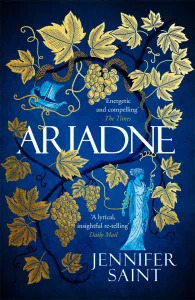 Jennifer Saint has become a cult favourite among lovers of mythological fiction over the last few years. And rightfully so. Her novels are strong, well-paced and compelling. Ariadne is a new take on what happens to the titular character after she is abandoned by Theseus – because who needs weak men like him? – and was a true pleasure to read in a single sitting. Elektra takes the reader on a journey to discover the lives of three women – Elektra, her mother Clytemnestra, and Cassandra, the Trojan princess brought back by her father as his spoils of war. I am looking forward to reading Atalanta when it comes out this spring – I’m sure it will be just as compelling and full of morally complex female characters!
Jennifer Saint has become a cult favourite among lovers of mythological fiction over the last few years. And rightfully so. Her novels are strong, well-paced and compelling. Ariadne is a new take on what happens to the titular character after she is abandoned by Theseus – because who needs weak men like him? – and was a true pleasure to read in a single sitting. Elektra takes the reader on a journey to discover the lives of three women – Elektra, her mother Clytemnestra, and Cassandra, the Trojan princess brought back by her father as his spoils of war. I am looking forward to reading Atalanta when it comes out this spring – I’m sure it will be just as compelling and full of morally complex female characters!
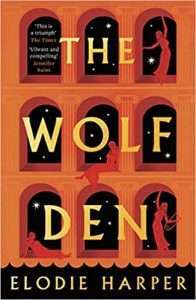 Elodie Harper’s The Wolf Den series isn’t quite a mythological retelling in the traditional sense. But it is set in Pompeii around the legendary Lupinarium – the titular Wolf Den and its brothel. And that makes it fair game to join this list to me – because this series is great and deserves all the love. Amara, the main character is a prostitute, a slave at the Lupinarium, brought there from Greece. She works hard to find a way out of slavery for herself. It is fascinating to see Pompeii come to life – a place I have always been fascinated by – and to meet so many fleshed out characters, both new and familiar from the pages of history. Read the full review of book one here – and look out for book three later this year!
Elodie Harper’s The Wolf Den series isn’t quite a mythological retelling in the traditional sense. But it is set in Pompeii around the legendary Lupinarium – the titular Wolf Den and its brothel. And that makes it fair game to join this list to me – because this series is great and deserves all the love. Amara, the main character is a prostitute, a slave at the Lupinarium, brought there from Greece. She works hard to find a way out of slavery for herself. It is fascinating to see Pompeii come to life – a place I have always been fascinated by – and to meet so many fleshed out characters, both new and familiar from the pages of history. Read the full review of book one here – and look out for book three later this year!
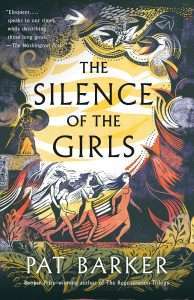 On the more literary end of the list, Pat Barker’s novels, The Silence of the Girls and the follow-up, The Women of Troy, are brilliant contenders to round off this list. While most stories and retellings focus on Helen – who I find to be a hugely over-rated character, especially as her importance is due to her looks alone making her a plaything of the gods – this instead is centred on Briseis. Trojan princess captured by the Greeks, Barker explores her life and the moral conundrums she faces as a slave in the enemy camp right outside her beleaguered home. These novels are slower than others on this list, but more introspective and pack no less of a punch.
On the more literary end of the list, Pat Barker’s novels, The Silence of the Girls and the follow-up, The Women of Troy, are brilliant contenders to round off this list. While most stories and retellings focus on Helen – who I find to be a hugely over-rated character, especially as her importance is due to her looks alone making her a plaything of the gods – this instead is centred on Briseis. Trojan princess captured by the Greeks, Barker explores her life and the moral conundrums she faces as a slave in the enemy camp right outside her beleaguered home. These novels are slower than others on this list, but more introspective and pack no less of a punch.
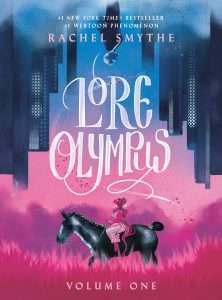 I decided to add Rachel Smythe’s Lore Olympus on as a bonus rather than a part of the list itself as it is on the fluffier end of interpretations of Classical mythology. A webtoon comic, it is available online here as well as in a printed edition published by Del Rey. A semi-modern take on the legend of Hades and Persephone, this is a story of love, toxic relationships and the gods we all love to hate. I adore the very limited colour palette, which makes this visually unique. Delightfully gossipy and a favourite of the team!
I decided to add Rachel Smythe’s Lore Olympus on as a bonus rather than a part of the list itself as it is on the fluffier end of interpretations of Classical mythology. A webtoon comic, it is available online here as well as in a printed edition published by Del Rey. A semi-modern take on the legend of Hades and Persephone, this is a story of love, toxic relationships and the gods we all love to hate. I adore the very limited colour palette, which makes this visually unique. Delightfully gossipy and a favourite of the team!
The post Classical Mythology Inspired Fiction: Where to Start Reading appeared first on Grimdark Magazine.
March 18, 2023
An Interview With Jane Yolen
Describing the breadth of Jane Yolen’s influence on modern readers is difficult. Yolen, a poet, journalist, fiction author, and children’s book author, has touched the lives and imaginations of every age bracket through her 400+ books. I spent hours entertaining my child with dinosaurs from Yolen’s children’s fiction series. And as an adult, I have read and enjoyed her twisted fairy tales, especially the fourth installment, The Scarlet Circus.
 Young, old, romance readers to the darkest of grimdark lovers will appreciate her mastery of language and storytelling. She honored us by sitting down and chatting with us about fairy tales, writing, and more.
Young, old, romance readers to the darkest of grimdark lovers will appreciate her mastery of language and storytelling. She honored us by sitting down and chatting with us about fairy tales, writing, and more.
[GdM:] You have a home in Scotland; what about Scotland draws you to the country?
My late husband was a professor at UMass, Amherst, and on his first sabbatical—partially because he was half Scottish (the Douglas clean, and partially because we had fallen in love with Scotland on an earlier trip top Britain, and partially because Scotland had a number of really good Computer Science departments in various universities, we took the sabbatical in Edinburgh. While there, he lectured at a number of other universities and discovered that the work being done in St Andrews most clearly matched his own. So on the next sabbatical we went there
Where I discovered a number of fantasy and sf writers and poets lived nearby. Plus, we fell in love with the house we were renting. Dear reader….er bought it!
[GdM:] When you write, how do you choose what to work on? Is it a matter of mood and inspiration, or do you have a more fixed idea of what needs to be done next?
JY:All of the above. Plus I regularly look back unfinished work or unsold work snd try to figure out what needs revising.
[GdM:] Are there topics that you will not write about poem-wise?
JY Nope. Anything goes.
[GdM:] As such a prolific poet, would you consider poetry your greatest love? If so, what about poetry attracts you so much to it?
{petry and fantasy were my first loves and it stuck. My favorite poems are “Jabberwocky” and anything by Dickinson or Yeats.“
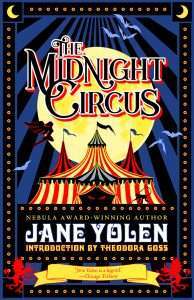 [GdM:] Are you still sending your subscribers a poem a day? To produce the poem a day, are you influenced by the news, world happenings, or something beautiful you saw while about in your daily life?
[GdM:] Are you still sending your subscribers a poem a day? To produce the poem a day, are you influenced by the news, world happenings, or something beautiful you saw while about in your daily life?
JY: All of the above, plus lines from favorite poems, newspaper clippings, something someone asked, or watching out my window and seeing squirrels and foxes and bobcats and bears and….it’s an old New England farmhouse with a lot of out buildings and farmland! Lots happening there every day.
[GdM:] You have added your own unique take on different Arthurian myths over the years. What draws you to the stories of Merlin, Guinevere, and Arthur?
JY: The very first books I read that stuck(I was a very early reader) were the two Alice in Wonderland books, and a book about Kind Arthur. Also, my parents let me read anything in their librairy and they had LOTS of books. Nothing was off limits. (I hope modern librarians and the nutcases trying to ban books in schools are listening!!! Reading widely and over my head, I became a world citizen. I have three children—they are writers and baturalists, and two grandklids who have books published as well. Reading things we didn’t know about or didn’t agree with, made us better citizens better humans, and. More interesting.
[GdM:] What advice would you give to an author who wanted to branch out into writing children’s books? What skills will they need that they might have yet to exercise in writing for a non-children audience?
JY: You do not have to have children (though sometimes it helps) but you should really sit down and read children’s books—not just the classics from when you were a child, but books that are being published now. Also join SCBWI. (Society of children’s book writers and illustrators—a 50-year opld organization.) Join your local SCBWI group and go to critique group meetings. Read, read, read. And as you are writing, read the words out loud because the great majority of children’s are read aloud by parents, grandparents, teachers, librarians, authors in the classroom. The ear is as important a reader as the eye.
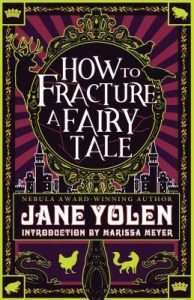 [GdM:] I am a Cat Rambo fan, and I particularly enjoyed The Reinvented Heart: Tales of Futuristic Relationships. Was it surprising that the book was organized around your poetic contributions, or was that planned?
[GdM:] I am a Cat Rambo fan, and I particularly enjoyed The Reinvented Heart: Tales of Futuristic Relationships. Was it surprising that the book was organized around your poetic contributions, or was that planned?
JY: I sent the poems in and I guess Cat liked them enough to include them that way. It wasn’t really planned.
[GdM:] Can you tell us about The Scarlet Circus?
JY: I had been doing a series of collections of m y published sf/fantasy poems Tachyon and the publisher and I were discussing what could be next. I had done a horror collection, a fairy tale collection, etc. He, “What about romance?” I replied, “I don’t write romance though some of my stories have Love in them.” (I was thinking about Romance Novels which is not my cuppa so I don’t read the genre.) “But…”I said .”not sure I have enough stories to fill a book. But I did. And since I—a widow of 17 years—had just remarried to an old college boyfriend (likewise a widower) it seemed prophetic.
[GdM:] How does an author fracture a fairy tale? How do you choose how much to break a story and how to put it back together?
JY: You begin by rereading favorite fairy and folk tales and take them apart and make them more modern (mostly meaning giving the females more agency!) or a different historical setting or giving them different voices. It doesn’t mean “breaking them –though the word fracture certainly pushes in that direction. For example: Ask yourself why we think a prince kissing a sleeping girl makes it romantic? Actually some earlier versions of the story have him raping the sleeping young woman and she wakes up a year later with twins.) Or why a prince with an enterouage sees a dead girl in a glass coffin and buys her from the dwarves. Using her for a coffee table display? Necrophilia? Something equally disgusting? Maybe dinner? Or ….when she wakes and starts talking, what does he do? Many short stories there I would think! Or novels. I wrote one of them—BRIAR ROSE a Holocaust novel.
[GdM:] What tale from the modern age might be taken and cracked in the future?
Depends. If it is an actual folk story (no copyright) or someone’s new fairy tale (copyright limitations.)
[GdM:] What is your favorite poem and fractured fairy tale in the collection, and why?
JY: I would rather tell you my favorite one in Scarlet Circus because it is the latest collection and the one I am right now closest to. My favorite story is “A Ghost of An Affair” because it feels as if it anticipated my marriage at 80 to my 82 year old husband. We who had dated in college and re-met as widow and widower. The time travel element is very real to us. As is the poem which I wrote for him at the beginning of our new relationship time travel indeed.
[GdM:] Your books, The Midnight Circus, The Emerald Circus, and now The Scarlet Circus, have a visual theme between them of circuses. What is the connection between circuses and these fractured fairy tales?
JY: Magic. Just magic.
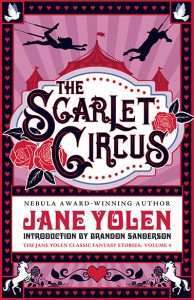 [GdM:] In the story notes and poems section of The Scarlet Circus, you mentioned that the poem “Hero’s Thumb” was published in your band’s 2018 CD. Now I need to know: how did your band form?
[GdM:] In the story notes and poems section of The Scarlet Circus, you mentioned that the poem “Hero’s Thumb” was published in your band’s 2018 CD. Now I need to know: how did your band form?
I was u0m and writing songs for a couple of musicians (both women) who decided to start a band.
We were the Three Ravens (there was a male guitarist) and Jane Yolen. I wrote a lot of the lyrics for songs, and read poems in between. We played a bunch of gigs and like many bands, broke up after a year.
[GdM:] The Scarlet Circus, features many different forms of love. I found your comments about two stories interesting: “Ghost of an Affair,” which you said is a reflection of your second marriage, and “Sea Man,” which focuses on family closeness. This one was written when your first husband was alive and well. How was the writing process on these two very personal stories different from some of the other stories in your collection?
JY: Hmmmm I don’t know. I didn’t realize until long after (when I was actually writing the back matter) that both were really part of my own personal story. But that’s what writers’ do, turn their own stories into something else. Sometimes magic, sometimes horror, sometimes a love song to their spouse and/or family. And sometimes, Isuppose, to get back at a bad relationship.
[GdM:] What are you reading right now?
JY: I just finished a new Peter Beagle story collection. WOW! Is he good. And the mss. Of a friend’s Holocaust novel that takes place in Hungary and is quite devastating, and my revisionans a trilogy of my own, middle grade novels about school children in nineteenth century Scotland who fight off monsters. They are organized and led by their schoool master and the three children each has a role: Pone is Tracker, one is Gaffer, and one is Bait. The Books are R and A (Royal and Ancient) Monster Hunters series. Probably out 2024 from Move Books, an imprint of Charlesbridge.
Thank you for taking the time to do this; I know you have a hectic schedule, and I appreciate being able to chat with you about The Scarlet Circus.
Interview was conducted by Beth Tabler and Jodie Crump
READ THE SCARLET CIRCUS BY JANE YOLENThe post An Interview With Jane Yolen appeared first on Grimdark Magazine.
March 17, 2023
REVIEW: Arca by G. R. Macallister
Arca by G. R. Maccalister is the second novel in Macallister’s The Five Queendoms series, picking up where last year’s Scorpica left off. It is published by the Saga Press imprint of Simon and Schuster in America and Titan in the UK. I had the pleasure of reading and reviewing Scorpica for Grimdark Magazine and was excited to get my hands on Arca. This epic matriarchal fantasy was a read I enjoyed. Although not very dark, it is a complex fantasy in a richly created world with equal beauty and brutality. Arca is now in North America and will be released in the UK in April 2023. G R Macallister has also published historical fiction as Greer Macallister.
The second novel in the series, Arca, is not where you should begin your journey into The Five Queendoms series. Scorpica is essential prior knowledge to understand the queendoms, their political hierarchies, religious pantheons, and the events in Scorpica which lead to the action of Arca. I enjoyed the first novel, but I should have reread it before jumping into Arca, as there is no preamble or summary explaining what occurred before this in the series. However, there is a list of the key characters of each Queendom, and I found this immensely helpful as a reminder before I started the novel proper.
Like its predecessor, Arca is also a multiple-perspective narrative, with some key characters being new to this story and others more familiar, having also appeared in the first novel. The primary setting this time around is the magical realm of Arca. Still, there are also relevant plots being woven through from the warrior women of Scorpica and the commercial queendom of Paxim. In a matriarchal system, most key characters are women, but that is sometimes their only similarity. Eminel has become Queen of Arca with no formal magical training and little understanding of her court. Heliane, Queen of Paxim, wants to make her son Paulus the first-ever ruling King. And Tamura, the Queen of Scorpica, is lurking in the mountain range that borders both countries with her army, poised to invade even though the Drought of Girls has now ended.
Macallister’s writing is ambitious and intelligent. Arca is engaging to read, even though there is a vast amount of world-building at play in this series. Each narrative perspective is equally interesting. Macallister deftly weaves through all the different storylines throughout the novel so that you do not get lost or confused about who is from where or what this character is doing. One of the only things I did not like about Scorpica was that the relatively short novel covered such a considerable amount of time, and Macallister’s sharp style left me wanting more detail about the world. It is not the case here. Although Macallister’s writing style is unchanged, the plot of Arca only covers about two years, and the novel itself is longer. Even though it took me a few chapters to get back to grips with the queendoms, this meant that overall I found it to be a more immersive reading experience. And although the novel is fast-paced, it did not feel rushed.
Arca has almost all of the elements I love in fantasy novels. It is a masterful showcase of powerful women with battles, magic, and politicking, which takes place in a queer norm world. You might get your throat cut in The Five Queendoms, but it will not be because of who you love. If you enjoy well-written epic fantasy with strong female characters, then a journey into The Five Queendoms should be on your to-do list. If you liked Scorpica, you would love Arca.
I would like to say a massive thank you to G. R. Macallister and the team at Saga Press for sending me a copy of Arca to review it.
4/5
Read Arca by G. R. MacallisterThe post REVIEW: Arca by G. R. Macallister appeared first on Grimdark Magazine.

